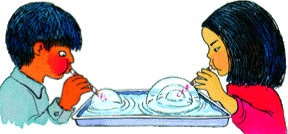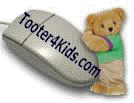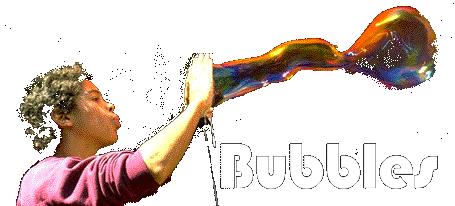|
Kids
love to blow bubbles! So could you imagine the fun of making your own
and having a contest to see who can come up with the biggest bubble!
What a wonderful end of the year project!
Below are
some wonderful web sites to help you measure, explore, and learn all
about bubbles before actually doing these activities. Then go to the
recipe part of this page.
Poems on
Bubbles

 
 Activities Activities
The
Bubbles Theme Page
Mrs. Elliot's Second Grade -
Lesson Plan: bubble making activity for the week
The Art
and Science of Bubbles - great site
Bubbles Activities and Games
Bubble
Geometry - making different shaped bubbles
Bubble-ology
and Bernoulli experiment
Bubble
Art
Secret
Bubble Solutions
Bubbles
from the Exploratorium -
http://www.exploratorium.edu/ronh/bubbles/bubbles.html
http://www.exploratorium.edu/snacks/soap_bubbles.html
James' Soap Bubbles, Slime, and More Page
The Bubblesphere
Bubbles from Jerrie Cheek,
Kennesaw State
University
ProTeacher - Bubble Lesson Plans
Brian Carusella's
Bubbles Page
Floating
Soap Bubbles
Bubbles Links, Activities, and Vocabulary

Bubble Recipes
All of these
bubble recipes make great bubbles for kids. The Magic Bubble recipe makes bigger bubbles that
last a bit longer.
~This
part is directly from: http://www.creativekidsathome.com/activities/activity_5a.html
|
Basic
Bubbles
2 T
dish soap
1 cup water |
Sweet
Bubbles
1 T
corn syrup
2 T dish soap
1 cup water |
Magic
Bubbles
1 T
glycerin
2 T dish soap
9 oz water |
Color
Bubbles
1 cup
liquid tempera paints
2 T dish detergent
1 T liquid starch |
Hints for making
bubble solutions
-
Mix up the
recipes the day before for best results.
-
Glycerin is
inexpensive and can be found in most drug stores. The children
think that the bubbles are so much better that it is worth keeping a
small bottle on hand.
-
Do NOT use the
Sweet Bubbles recipe if you have bees or wasps in your yard.
-
Color Bubbles
can be a bit messy. Be sure to use paint that can wash out. You
can add a little water if the mix is too thick.
Children are often
surprised when they realize they can do a craft project to make their
own bubble wand. A basic bubble wand can made from a stick with any
type of loop on top. Use any materials you have on hand, or try one of
these ideas. Once the children have seen the options, let them
experiment with the craft supplies to make their own wands.
-
A 12 inch
piece of coat hanger with 10 inch piece of string tied in a loop on
one end.
-
Cut the center
out of a plastic lid (yogurt or margarine container) and thumb tack
it to a wooden chopstick.
-
Cut the top
and bottom off a can of tuna, creating a 1 inch tube. Check for
sharp edges before letting the children have it. Put the bubble
solution in a pie plate to make it easy to dip the can.
-
Buy a set of
10 inch bubble wands and keep them from year to year.
Here are some
ideas sent in by our visitors.
-
"We have had
great luck making giant bubbles by using cotton string and straws to
make wands. Cut two sections of straws, about 6 inches long. Cut a
string about 24 inches long. Pull the string through the straws, tie
the string in a knot, and hide the knot inside a straw. By putting
your hands on the straws and pulling, you create a square or
rectangle. Dip this form into the pan of bubble solution, and gently
draw it through the air. Voila, a giant bubble."
-
"We made
bubble wands using twigs found in our back yard. Have the children
look for pine twigs that have recently fallen (flexibility is the
key). Wrap the twig tightly with yarn starting from about 1/3 of the
way up and wrapping to the tip. Bring the tip around to your
starting point, making a circle, and tie it down by wrapping around
where the twig crosses itself. The longer the twig, the bigger the
circle, the larger the bubbles. Use any of the bubble recipes and
enjoy. We used this as a children's birthday party craft (for older
children or adult assistance for younger children) and found it a
nice way to bring all the kids together on a sunny day."
-
"At our
preschool I purchased fly swatters for the children to use as bubble
wands. Even the toddlers have great success making millions of
bubbles."
-
"Use a fairly
rigid drinking straw, the fancy reusable ones work best. (You want
straws with a fairly small diameter hole.) Have the child insert
both ends of a 12" length of chenille into one end of the straw and
form the loop into a 2-3" circle. You can make 20 - 50 bubbles from
one dip of bubble mix!"
-
"Those little
green baskets that strawberries come in make excellent bubble
blowing tools. You can't blow very big bubbles, but kids can make
lots and lots of little bubbles. Plus, it's recycling!"
-
"We had a lot
of fun using plastic cookie cutters to blow bubbles. My daughter is
fascinated by Count Von Count on Sesame Street, so we used big and
small numbers. We tried lots of bubble solutions and had a blast in
the back yard."
Here's an
interesting idea for blowing bubbles sent in by one of our visitors.
After watching
the clowns at the circus make bubbles with their hands, my son and I
went home and tried it. It took a little practice, but now my 5 year
old child does it with ease. You dip your hands in the bubble
solution (shampoo in the bath is the cleanest) lock your two thumbs
then slowly spread them to make a circle. Blow gentle and you will
get massive bubbles.

|

